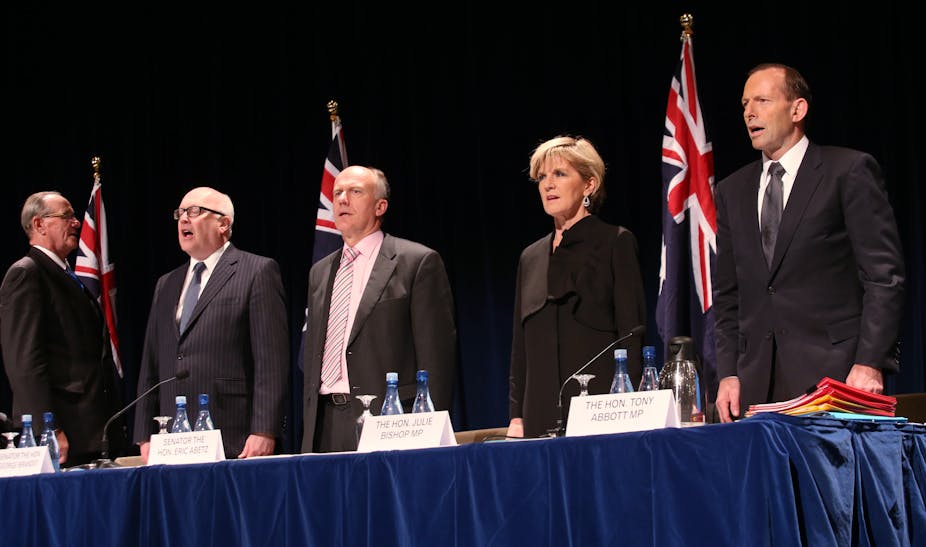Tony Abbott’s “Team Australia” is a confusing concept. The latest image of Australian nationalism is headed by a staunch monarchist who campaigned against a local head of state. The same “captain” recently revived the British system of honours, which were seen as so foreign that even John Howard, hardly a republican, labelled them “anachronistic”.
Abbott’s nationalism isn’t about cultural independence or the construction of a distinct Australia. Like Howard in the early 2000s, it’s defined in opposition to a military threat, not an overbearing Britain or United States.
The language of Team Australia reflects the Abbott government’s pivot from domestic to foreign policy. The military success of Islamic State in Iraq - and the small number of Australians joining its crusade - has put the question of national loyalty back at the centre of politics.
But if Abbott is now trying to own it, Australian nationalism hasn’t always been the natural home of conservatives.
Nationalists once came from the left
In the 19th century, the nationalist tradition was much more likely to be associated with the radical and republican left. Henry Lawson, a poet who flirted with socialism, defined nationalism in opposition to a Britain that belonged to “the lord and the Queen”. He described this as a choice between “the old dead tree and the young tree green”. Lawson’s mother Louisa, a republican and early feminist, wrote poems with the chorus “Australia forever!”.
Revolving around the popular Bulletin magazine, this brand of nationalism emphasised cultural independence and egalitarianism. Its obvious downside was that, because it valued isolation, it tended towards an ugly form of racism. For years, The Bulletin’s motto was “Australia for the white man”.
Nationalism as a loyalty test
During World War I, Australian nationalism took a different, sectarian turn. Prime minister Billy Hughes accused opponents of conscription of variously being German sympathisers, Irish republicans and industrial revolutionaries. Nationalism was now defined as unquestioning loyalty to a country under military threat.
Under the leadership of Archbishop Daniel Mannix, Irish Catholics were particularly suspect. William Holman, a Labor premier who supported conscription, later admitted that this was Hughes’ deliberate attempt to harness anti-Catholic sentiment.
Hughes’ nationalism was very different to the one expressed by the Lawsons. It valued loyalty, not independence, and feared military vulnerability, not imperial influence. It defended Britain, it didn’t rebel against it.

The Cold War revived this style of nationalism. Robert Menzies claimed that Australia must prepare for World War III against the “communist forces of the world”. With the Liberal Party attempting to ban the Communist Party following industrial unrest in the late 1940s, patriotism was defined as a commitment to liberal capitalism.
Those who didn’t toe the line were accused of treachery. The Sydney Morning Herald argued that “any Australian born in this country who embraces Communism is a traitor - there is no half-way”. H.V. Evatt, the Labor leader who opposed the bill, was deemed insufficiently loyal. Harold Holt described him as “the most notable defender of Communism in Australia”.
A ‘new nationalism’ emerges
Australian nationalism again reversed in the 1960s and 1970s. As Britain removed its military from Asia and attempted to join the European Economic Community, Australians again looked to their own independent identity. This was known as the “new nationalism”.
Gough Whitlam embraced the term. According to Whitlam, the new nationalism meant “self-confidence, maturity, originality and independence of mind”.
In its first year in government, Labor dumped God Save the Queen as the country’s anthem. Whitlam went to Britain to remove the Privy Council as the last court of state legal appeal. He considered it “humiliating” that a foreign body had the final say over Australian laws.
While embraced by progressives intellectuals, the “new nationalism” wasn’t the sole domain of the left. John Gorton was also an enthusiast. The Liberal prime minister shocked Alexander Downer senior when, while driving through London, he described England as a “foreign country”. We owe the Barry McKenzie movies to Gorton’s funding of Australian film.
Back to wartime nationalism
Abbott’s “Team Australia” fits into the nationalist tradition of World War I and the 1950s. It also follows Howard’s approach to nation. Howard wanted to quash the “perpetual seminar” on national identity, which he associated with Paul Keating’s republicanism.
Progressive nationalism still lingers in the Australian left, though the republican movement currently lacks vitality. Philosopher and Race Discrimination Commissioner Tim Soutphommasane has written about “reclaiming patriotism”. But many progressives now see nationalism as opposing universalism and defending war and cruelty. After Tony Abbott announced “Team Australia”, Twitter users responded with the #TeamHumanity hashtag.
It’s sometimes said that the prime minister has the second most important job in the country - just after the Australian cricket captain. Where does that leave the captain of “Team Australia”? With Abbott increasingly emphasising his own brand of Australian nationalism, we’ll soon see.

